Chapter 27 – Pollination and Pollinators
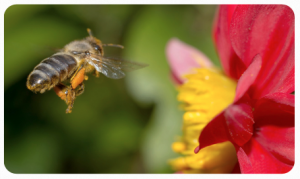
On a typical day, most Americans probably don’t think about insects at all. But that changed to a limited extent in the early 2000’s when reports of a crisis in honey bees (Apis mellifera) hit the news reels. However, let’s be realistic. Even with saturation coverage by the 24 hour a day news cycle, most Americans still didn’t lose a lot of sleep over it. But elsewhere on the planet, the rapid decline in honey bees spelled both economic and ecological disaster. And as time went on and food prices reflected what was happening to honey bees, some Americans did begin to take notice. To some extent, the situation has stabilized, but the problem has not been “fixed,” and we will likely visit this issue again. It is, therefore, wise to understand the nature of the problem and the preventative measures we can take to avoid, or at least ameliorate, future difficulties.
What do Honeybees do for Us?
To begin to understand the components of the honey bee “problem,” we need to understand the process of pollination and the reasons that it is important to us. This, in turn, requires us to know a little about plant biology and the ecological relationship between plants and pollinators. These are simple matters of science. But the reasons why we have a honey bee crisis have some interesting human dimensions that rapidly morph into how and why honey bees are raised, the nature of the humans who are involved in that production and the policies that have been written to govern how honey bees are treated under the law.
It is a fascinating exploration of how humans feel about insects, fear of insects, resentment of regulation and several other psychological dimensions that we have been exploring throughout this book. As an aside: a photo credit. The photos that you see in this chapter were taken by professional photographer, Karina Wetherbee of PhotoBrilliance, as part of a joint project we had to establish a pollinatarium at The Ohio State University (OSU), which will be discussed at the end of this chapter.
Why do we care about honey bees? One reason is that, in the state of Ohio, about 30% of our fruits and vegetables require honey bees to pollinate them. Without honey bee pollination services, these crops would be much more expensive than they are today. A few of the crops that require honey bee pollination appear in Figure 27.1a-d.
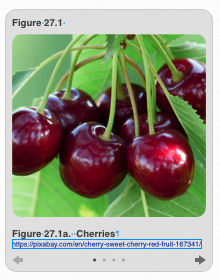
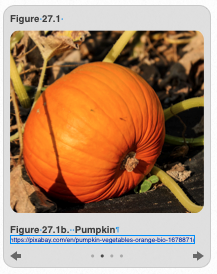
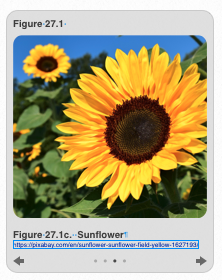
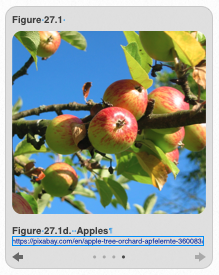
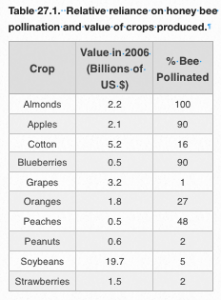
Not all crops are dependent on honey bees for pollination. And among those plants that use honey bees for pollination services, not all plants are equally dependent on honey bees for this purpose. Table 27.1 shows the relative reliance on honey bees for pollination services for a series of commodities. Clearly, almonds which have an absolute dependence on honey bees for pollination will suffer a greater impact from any decline in honey bee populations. In contrast, soybeans, which are grown in large amounts across the U.S. and are, therefore, very valuable, will be less impacted by declining honey bee populations because soybeans are much less reliant upon honey bees for pollination services. But, if we look at the cumulative total of all pollination services provided by honey bees annually in the U.S., the value is in excess of $16 billion making it a significant monetary asset.
Another reason that we care about honey bees as pollinators is that a very large variety of plants which we do not harvest commercially, but are nonetheless important, are pollinated by honey bees. Plants are the base of the food chain in terrestrial ecosystems and, while humans may not eat these plants directly, we depend on them for other reasons. Figure 27.2 gives a pictorial view of one fairly simple set of ecological relationships that are honey bee-dependent.
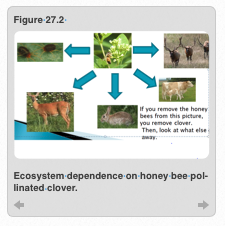
Clover is the keystone species in the food chain pictured here. If honey bees are removed, there will be less clover and, to the extent that each species is dependent on clover, there will be fewer of those species as well. Some of the animals will be able to switch to a non-honey bee pollinated food source. But, all of the animals depicted will be impacted.
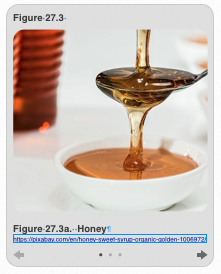
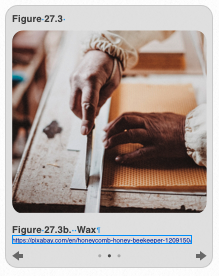
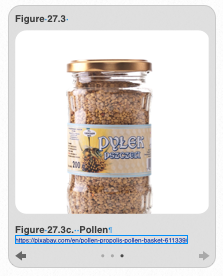
Let us also be clear that it is not merely the pollination services provided by honey bees that make them valuable but the fact that bees produce a number of products that humans find useful. Several of these appear in Figure 27.3. Obviously, bees produce honey, which is an important commodity in the human economy.The same is true for mead, an alcoholic beverage made from honey.The former are merely the edible commodities made by honey bees.
To fully understand their usefulness to human beings, we would have to include honey bee venom which, although not an asset when the venom is administered by the honey bee through its stinger, we can used the purified venom to habituate people who are allergic to it so that it doesn’t kill them if they are stung by an actual bee. Additionally, people also have been using bee venom therapy to treat a variety of illnesses including arthritis and even Lyme disease. However, bee venom therapy has not been clinically tested in large trials, and therefore its efficacy has not been established and is not currently recommended by most medical doctors in the US.
Humans have made good use of honey bee wax. The wax is produced by the bees and deployed in the hive to make honeycomb where the pollen, honey and young bees are kept. We can, of course, appropriate the wax and employ it for a variety of our own uses including:
• Freeing up rusted metal bolts
• Waterproofing leather
• Beeswax candles
• Coating thread to avoid tangling
• Cosmetics (thanks Burt’s Bees!)
• Coating metal tools to prevent rust
• As a finish on bare wood
• Various pharmaceutical uses
Finally, propolis made by bees has found use as a dietary supplement. Propolis is a resinous substance that bees collect from trees and other plants. The bees modify the plant material chemically and use it for structural purposes within the hive including sealing holes. Propolis has antibacterial and antiviral properties and helps protect the hive from becoming septic. Propolis has been used for its antiseptic properties by humans. It has also found use among humans as a means of preventing dental plaque. In addition, the National Institutes of Health rates propolis as being “possibly effective” for the treatment of cold sores, genital herpes and post-surgical mouth pain.
In the United States, honey production is a niche market. It is small its total sales ($150 million per year) but it tends to be very important to the small number of people who produce it. In 2006, before the honey bee crisis hit, honey in the U.S. was produced by roughly 135,000 beekeepers who tended 2.44 million honey bee colonies. In 2007, 148.5 million pounds of domestic honey were produced from all forms (honey, candy made from honey, propolis, wax and pollen). The honey market in the U.S. has also been negatively impacted by the sale of imported honey, which is generally sold at a lower cost than U.S. products.
What do Honey Bees Have to do with Pollination?
Flowering plants, also known as angiosperms, evolved a mode of reproduction that requires pollination. So let’s start with a brief look at what that is all about. The graphic in Figure 27.4 summarizes just about everything:
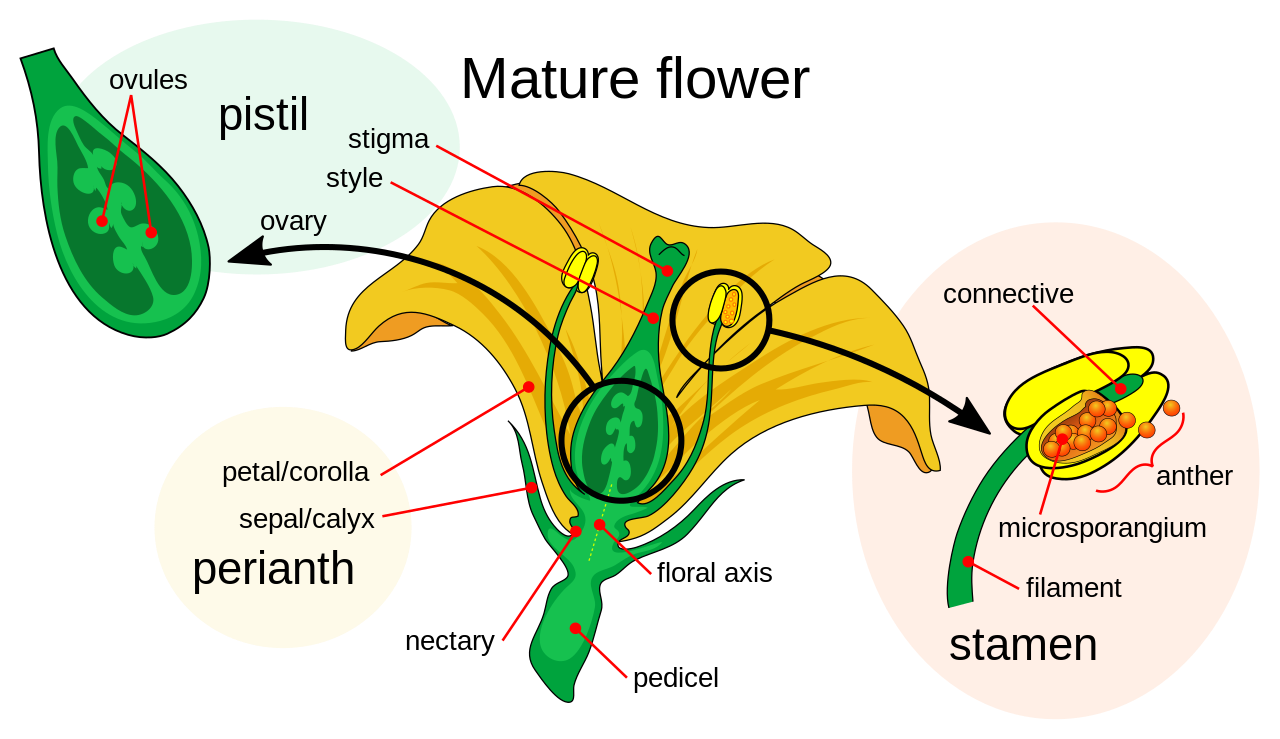
Figure 27.4: Parts of a flower
Flowering plants reproduce sexually. Yes, flowering plants have sex! This may strike you as offensive and unnatural, but it is actually helpful, because much of their reproduction is like ours (except for the bars, sexy clothes, and loud music). Flowering plants have male reproductive parts called anthers that produce male gametes which we collectively call pollen. Similarly, the female plant has female sex organs: a carpel that consists of a part that sticks out called the stigma, a tube that leads away from the stigma called the style, and a larger base (ovary) that contains the female gametes (ovules) and will protect and shelter the developing embryos.
As is the case for humans, we have to have a way of getting the male gametes together with female gametes to join together and form a zygote. This can be tricky in plants, especially if the male and female parts are on different flowers or different plants. So, plants have evolved multiple strategies to get the male and female gametes together and most of them involve having the male gamete or pollen find the female flowers. The assumption here is that the male pollen will be out there, using wind, rain, or pollinators to get the pollen to the stigma. If successful, the pollen grain will develop a pollen tube through which the male gamete will move from the stigma, down the style and into the carpel where the two sex cells can join. The zygote, or developing seed, is formed and protected until released into the environment—but that is another story.
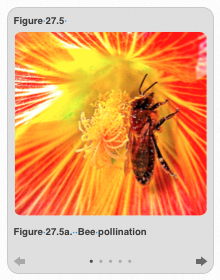
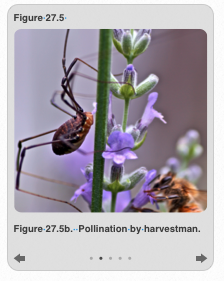

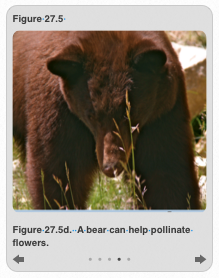

Plants rely heavily on pollinators to perform the action of getting pollen from one plant to another to make reproduction possible (Figure 27.5). Sometimes there is a reward in it for the pollinator, such as in the case of honey bees, butterflies, and humming birds who feed upon the nectar provided by the plant and pick up pollen in the process. When these organisms visit a second flower, the pollen rubs off on the new flower thus completing the act of pollination. Flowers, not surprisingly, have many adaptations to lure the pollinators in and provide them with an incentive to keep the pollination going. Other pollinators, such as bears, dogs, spiders and people are called incidental pollinators. Their activities can cause pollen transfer and cause pollination just by chance—not because plants have successfully ensnared us in their reproductive strategies. The pollen basically hitches a ride on a passing vertebrate and uses their activity to find another flower and seal the productive deal.
Because honey bees have evolved a symbiotic relationship with plants and because honey bees produce portable hives that contain thousands of bees, humans have found it convenient to focus on honey bees as a source of pollination services.
What is the crisis with honey bees?
The analysis presented in this chapter focuses on events occurring in the state of Ohio for which the data are available and reliable as a result of the work of the Ohio Honey Bee Task Force appointed by Governor Strickland in 2010. The number of honey bee hives has declined nationally from a high of 330,000 in the 1940’s to 14,538 colonies in 2009. The decline in the number of hives is, thus, close to 95% over a 60-year period. The decline parallels a number of societal changes, e.g., reduction in the number of family-run farms, expansion of suburban living into previously agriculture zones and increased litigiousness in response to bee stings and other inconveniences of operating bee hives. In addition, the keeping of bees requires substantial training, which is less available now than even 10 years ago due to the reduction in extension training and educational services. Thus, the number of active beekeepers in Ohio has declined from 5,000 in 1940 to 3,985 in 2009. Fortunately, however, there is a hybrid course on Beekeeping offered through the Entomology Department at OSU (online lecture; in-person lab) that you can and should take if you are at all interested in learning how to become a beekeeper!
While the numerical decline of beekeepers may not appear alarming, the average number of hives kept per beekeeper has dropped precipitously, and accounts for the overall decline in the number of hives in Ohio. Also implicated in the decline of honey beekeepers is the emergence of Africanized forms of bees which are more aggressive, difficult to tend and more likely to cause legal entanglements. Thus far, there have been no confirmed reports that Africanized bees have been established in Ohio but the potential for Africanized bees is enough to quell the enthusiasm of beekeepers whose passion for keeping bees is less than ardent.
Additionally, 2020 brought additional concerns for beekeepers. Along with the global coronavirus pandemic, murder hornets were found in Washington state and British Columbia in Canada. These large wasps (queens can be up to 2 inches long) can deliver painful stings that can even draw blood and can be lethal if a person is stung by multiple wasps; approximately 50 people die each year in Japan as a result of their stings. As terrifying as the wasps are for people, they are even worse for honey bees. A handful of these wasps is capable of killing an entire colony of honey bees. The wasps decapitate the bees and fly back to the wasps nests with the bees’ thoraxes and abdomina which they feed to their own developing larvae. Given the incredible damage that murder hornets can inflict on bees, it is no wonder that scientists and beekeepers are working to eradicate and eliminate the wasps from North America. Hopefully they will be successful and murder hornets will never make their way to Ohio.
Honey bee colonies in Ohio and, indeed, the rest of the nation have been plagued by invasion of a series of pathological and ectoparasitic organisms that have reduced honeybee survival in commercial and private hives. American foulbrood (AFB) is a bacterial disease that has been afflicting hives since the 1960s (Figure 27.6). Spores are found in virtually every hive but the disease is generally dormant until a hive is under stress, at which point the bacteria propagate and kill the bees. The disease is treatable with strict hygienic practices and antibiotics, although bacteria are starting to become resistant to existing antibiotics. However, the normal practice is to eliminate the hive when AFB is found upon inspection. This has had the untoward effect of reducing compliance with inspections in Ohio.
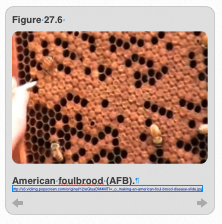
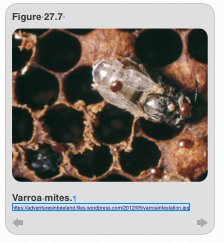
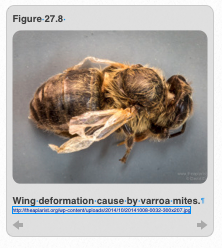
During the 1980s honey bee hives were infested with two species of mites. Varroa mites feed on the bodily fluids of adult, pupae and larval bees (Figure 27.7). This mite also transmits a viral disease that causes deformed wings in bees (Figure 27.8). The mites are generally held in check until the hive is stressed at which point the impact of the mites can be severe. Both feral and commercial hives have been heavily impacted by Varroa in Ohio. Similarly, tracheal mites (Figure 27.9), which invade the respiratory system of bees, have decreased survival among Ohio honey bees.
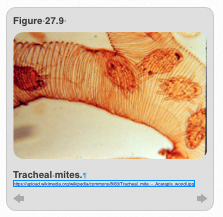
Colony collapse disorder (CCD) is a term used to describe the massive disappearance and presumed die off of worker bees in a hive. CCD has been reported (albeit with a different name) throughout the history of apiculture. The most recent CCD event occurred in the United States and much of Europe in 2006. Reductions in honey bee hives of 50% or more have been reported. In Ohio, the number of hives declined from 21,000 to 15,000 in the time period between 2005–2007 suggesting that CCD may have played a role.
Despite the often dramatic reductions in hives putatively as a result of CCD, the cause(s) of CCD remain(s) obscure. Some scientists have adduced a pathogen such as Israeli acute paralysis virus as the leading cause of CCD. However, not all hives showing dramatic decreases in bees have the virus. A newly discovered microsporidium that causes dysentery, Nosema ceranae, has been linked to CCD as well. (Note that this pathogen is closely-related to the parasite that caused pebrine illness in silk moths; they are in the same genus.)
Other scientists and beekeepers have argued that parasites like Varroa and tracheal mites are responsible for CCD. A cogent argument can be made that certain new pesticides on the market, e.g., neonicotinoids, such as Imidacloprid, are the source of the die-off. Environmental conditions such as unusually cold and long winters have also been implicated, as have more exotic ideas such as cell phones and genetically modified crops. The consensus view is that CCD is due to multiple causes and that the contribution of specific causes may vary over time and with geography.
In short, CCD, is a highly visible reminder that bee hives are vulnerable to environmental conditions, the invasion of pathogens and ectoparasites and a host of other problems. CCD is not, in itself, responsible for the decline in Ohio bee hives. Rather, this is a trend that has been underway for decades. The decline in honey bee hives may have stabilized. However, the numbers are now low enough that a severe winter or unpredicted random event could wipe out the remaining hives. Just as the causes of the problem are multidimensional, attempts to mitigate and reverse the trends must be multifaceted.
Other Factors Affecting Honey Bees in Ohio
Roughly 30% of Ohio crops require honey bees to pollinate them. The current number of honey bees is insufficient for that task. In 1998, 2.5 million honey bee hives were available for rent to pollinate crops nationally. However, 1/3 of these hives were used to pollinate almond trees, siphoning off a significant proportion of the available commercial hives. As the number of hives has declined nationally due to CCD and related causes, the number of rental hives has declined and the price of renting a hive has increased dramatically. From 2004–2007, the cost of renting a hive to pollinate California almonds rose from $50 to $150 per hive.
A related problem is that there is very little monitoring of out-of-state hives and virtually no inspection of out-of-state hives when they cross state lines. The contracts to provide hives are negotiated between private growers and private honey bee providers. Although the law requires inspection of honey bees crossing state lines, there is no enforcement and, at present, no manpower to attempt it. Thus, out-of-state hives could be bringing honey bee diseases or parasites to Ohio and we would have no way of knowing about it until after an outbreak occurs. Further, some growers import hives from multiple providers which significantly increases the possibility that diseases or parasites will be spread among colonies.
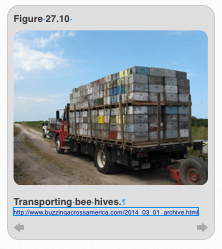
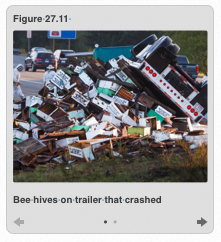
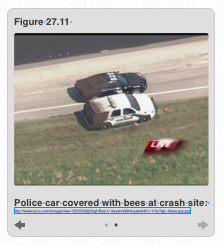
The importation of hives is also a logistical nightmare. Figure 27.10 shows a semi-tractor trailer loaded with bee hives. This is the manner in which bee hives are transported from their source of origin around the continental United States. When they arrive at their destination, the hives are offloaded and distributed around the field. Imagine the result if just one of these uninspected hives had Varroa mites, tracheal mites, Nosema, American foulbrood or acute Israeli paralysis virus. What would the result be among native bees in and around the site of deployment? Also, one can easily imagine the chaos that would result if one of these fully loaded trailers crashed. In fact, we don’t have to imagine this. The internet is filled with pictures of this event such as the one you see in Figure 27.11 (click the link).
Lack of Inspection
Ohio law is antiquated with respect to honey bee inspections. The law requires inspection of individual hives or 2/3 of the hives at large commercial operations each year. As recently as 1990, Ohio had seven fulltime state apiary inspectors. Since that time, Ohio has lost all of its fulltime state inspectors due to budget cuts. In the 2012 biennial budget, a Plant Pest rotary fund was created. The Ohio Department of Agriculture worked with the Ohio Nursery and Landscape Association to help the Plant Pest fund become self-supporting through an increase in processing fees. Twenty-seven thousand dollars of this fund has been set aside to pay 50% of the salary of a state apiarist to monitor and coordinate the activities of the county inspectors. Counties have been filling in the role of honey bee inspectors but Ohio has 16 vacant county apiary inspectors now and, during these tough economic times, they are likely to remain vacant. In addition, bee keepers are allowed to exempt themselves from inspection by filling out a “no consent” form. A court order is then required to inspect the hive under Ohio law. Moreover, a ridiculously low fee of $5 is charged for an apiary license and the charge is $5 per apiary, not per hive. Thus, an apiary with 200 hives pays the same $5 fee as a backyard apiarist who has one hive. And, finally, the $5 levied goes to the general fund of the State of Ohio—not to fund the Apiary Program. If the state of Ohio wants to be serious about inspecting the health of hives and preventing the transmission of disease and parasites, we need to reconsider the law and adequately fund enforcement activities.
Education
It is clear that one component of the current crisis is an educational crisis. In K-12 education, students are not taught about the importance of honey bees and the pollination services they provide in food production. Because they are not educated about this as children, they are not concerned as adults when honey bees are imperiled.
At Ohio State University (OSU), once the beacon of high-quality information about honey bee biology and genetics and site of the world-renowned Rothenbuhler Bee Lab, the investment in honey bees has been gutted in the last 15 years. The Bee Lab was closed after Director Brian Smith left for another position. The bee hives were transferred to Wooster and another researcher took possession of the hives. However, the new researcher was already overburdened by budget and personnel cuts. He nonetheless became the sole source of honey bee expertise for the State of Ohio and did his best to keep research on honey bees going in Ohio. Sadly, he retired in 2012. Fortunately, a new and top-notch honey bee researcher was hired by the OSU Entomology department, Dr. Reed Johnson, who joined the faculty in 2014.
Extension programs on bees, conducted through OSU, have also been curtailed due to budget cuts. Beekeeping is becoming a lost art. It is a fairly specialized field of knowledge, which, in the past, has been passed on from one family member to another. As beekeepers die or retire from the craft, the knowledge about beekeeping that they hold is not being used to create a new generation of beekeepers. On the positive side, more people are attending beekeeping expositions and classes suggesting renewed interest. However, there needs to be more access to extension programming and more coordination of effort with existing resources. In addition, we need to bring additional expertise into the mix, e.g., using Master Gardeners to help teach about the importance of bees and new extension programs to cultivate new beekeepers. Finally, existing beekeepers need to be encouraged to add new hives to new locations where pollination is needed and growers need to be educated to understand the needs of bees and beekeepers.
A common problem each year is that pesticide applicators spray fields adjacent to apiaries causing bee loss. In most cases, the applicators either didn’t know they were supposed to alert beekeepers, didn’t know how to contact the beekeeper, or didn’t know why they needed to contact the beekeepers. Similarly, beekeepers need to work with local growers and pesticide applicators to cultivate a relationship of trust so that the incidence of unannounced pesticide applications is reduced.
Impact of Honey Bee Losses on Ohio
As the number of honey bee hives in Ohio declined, there was also a decline in honey production. The U.S. consumption of honey is 1.1 lb per year per person, amounting to 323 million pounds of honey each year. In contrast, the US production of honey has declined to 150–185 million pounds per year (USDA 2009). As a result of the discrepancy between demand and supply, honey is being imported at a greater rate each year. Since the cost of production of foreign honey is lower than the production cost in the U.S., foreign honey is cheaper than domestic honey, leading to a negative feedback cycle in which more honey is imported because it’s cheaper leading to lowered incentives to produce domestic honey. When one adds in the costs of treating for pests and diseases, the potential for having Africanized bees and murder hornets, the threat of CCD, and the increasing difficulty of finding sources of education about beekeeping, the pressure to discontinue beekeeping activities or to not replace failed hives increases.
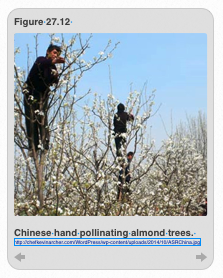
Although Ohio and other U.S. states are producing less honey, we can at least take comfort in the fact that our honey bees have not been eliminated as they have in other places around the world. In some parts of China, for instance, there are literally NO honey bees available to pollinate crops such as almonds that must have honey bees for pollination. The solution is shown in Figure 27.12. Human workers armed with paint brushes are needed to hand-pollinate almond flowers. Obviously, this is not a solution that is sustainable and should honey bees continue to decline, it will become a problem whose solution will become increasingly urgent.
Chapter Summary
The reality is that the honey bee problem is multifaceted. To fix the problem, it will require coordinated effort, a multifaceted approach, a broad geographic application, compliance with inspection, and a budget that does not make a mockery of the effort. At the current time, none of that is in evidence. We have the knowledge to ameliorate the problem. Do we have the will? It is an open question. At a minimum, we can expect the cost of honey bee pollinated food to rise as our populations of honey bees decline.
In many respects, the honey bee crisis in the U.S. is perfectly understandable in light of the problematic relationship that exists between humans and insects as detailed in this book. We ignore insects for the most part, until they cause some sort of problem, at which point, we may be motivated to address the problem in a short-term way. However, our history with insects suggests that we are not very good at or interested in a sustained relationship with insects that requires investment of resources and a nuanced understanding of insects’ role in the ecology of our planet or the status of our economy. Our hope is that, through education about insects through all of the modalities we have available will teach us to understand insects as creatures worthy of our time and attention, as capable of bringing us fascination and delight as they are of causing fear and loathing. This book is dedicated to that end.
References
Chapter 27 Cover Photo: Honey bee. CC0 Public Domain: spider0702. Accessed via pixabay.com
Figure 27.1a: Cherries. CC0 Public Domain: Hans. Accessed via https://pixabay.com/en/cherry-sweet-cherry-red-fruit-167341/
Figure 27.1b: Pumpkin. CC0 Public Domain: Couleur. Accessed via https://pixabay.com/en/pumpkin-vegetables-orange-bio-1678871/
Figure 27.1c: Sunflower. CC0 Public Domain: ulleo. Accessed via https://pixabay.com/en/sunflower-sunflower-field-yellow-1627193/
Figure 27.1d: Apples. CC0 Public Domain: keywest3. Accessed via https://pixabay.com/en/apple-tree-orchard-apfelernte-360083/
Figure 27.2: Ecosystem dependence on honey bees. Image author unknown.
Figure 27.3: Products of honey bees. CC0 Public Domain images.
Figure 27.4: Process of plant pollination. Image author unknown.
Figure 27.5: Pollination by various animals.
Figure 27.6: American Foul Brood: http://s3.vidimg.popscreen.com/original/12/eGtyaDM4MTI=_o_making-an-american-foul-brood-disease-slide.jpg
Figure 27.7: Varroa mites: https://adventuresinbeeland.files.wordpress.com/2012/05/varroainfestation.jpg
Figure 27.8: Wing deformation caused by Varroa. http://theapiarist.org/wp-content/uploads/2014/10/20141008-0032-300×207.jpg
Figure 27.9: Tracheal mites: https://upload.wikimedia.org/wikipedia/commons/8/83/Tracheal_mite_-_Acarapis_woodi.jpg
Figure 27.10: Transporting bee hives. http://www.buzzingacrossamerica.com/2014_03_01_archive.html
Figure 27.11a: Bee hives on trailer that crashed.
Figure 27.11b: Police car covered with bees at crash site. http://www.koco.com/image/view/-/35559332/highRes/1/-/maxh/480/maxw/640/-/110x7gb/-/bees-jpg.jpg
Figure 27.12: Chinese hand pollinating almond trees. http://chefkevinarcher.com/WordPress/wp-content/uploads/2014/10/ASRChina.jpg
Table 27.1: Value and percentage of crops pollinated by honey bees. Data source unknown.
Additional Readings
Nordhaus, H. (2011). The Beekeeper’s Lament: How One Man and Half a Billion Honey Bees Help Feed America. Harper Collins, New York, 288 pages.
Testimony to the House of Representatives, 110 Congress (2007). Review of Colony Collapse Disease in Honey Bee Colonies Across the United States. Testimony to the Subcommittee on Horticulture and Organic Agriculture of the Committee on Agriculture of the U.S. House of Representatives, U.S. Government Printing Press. Available at https://www.gpo.gov/fdsys/pkg/CHRG-110hhrg36465/html/CHRG-110hhrg36465.htm
United States Department of Agriculture (USDA) (2012). Report on the National Stakeholders Conference on Honey Bee Health. 72 pages.